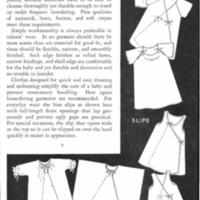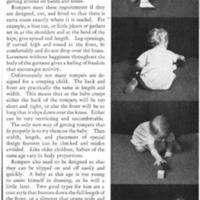Fabrics and Designs for Children's Clothes
Title
Fabrics and Designs for Children's Clothes
Date
1937
Relation
U.S. Department of Agriculture
Farmers' Bulletin Number 1778
Excerpt
For some years the Bureau of Home Economics has been studying fabrics and designs for children's clothing in response to two widespread demands.
Both producers and consumers are seeking new and better ways of utilizing fabrics made of cotton and wool, the textile fibers of great importance to American agriculture. Cotton is particularly well adapted to garments that must be laundered frequently and are soon outgrown and must be replaced. For outer wraps and other purposes where warmth is needed without excessive weight and bulk, wool is desirable.
The more recent scientific approach to child care and training has focused attention on the special clothing needs of children. Particularly for infants and young children, clothes are found to have pronounced effect on health and habit formation.
The sunsuit, for example, follows the discovery that the ultraviolet rays in sunlight shining directly on the body aid in preventing and curing rickets. Self-help features are incorporated in many garments to encourage initiative and self-reliance in early childhood. The modern one-piece protective playsuit, which enables a child to play actively out of doors for long periods in all kinds of weather, is the result of careful study of fabric and garment design. Even colorful outdoor clothes that make children more visible to the motorist are of value in preventing traffic accidents.
All of the garments pictured in this bulletin have been designed in the Bureau of Home Economics. They were first made up experimentally and then, in cooperation with mothers and nursery-school teachers, tried out on children. Many of the most popular designs have been reproduced by commercial pattern companies and so made available to the general public. The Bureau itself has no patterns for distribution. It has, however, arranged to lend traveling exhibits of the actual garments to extension groups, child clinics, and nursery-school centers.
The principles of fabric selection and garment design are outlined here as helps in making children's clothes at home and in buying ready-made garments.
Both producers and consumers are seeking new and better ways of utilizing fabrics made of cotton and wool, the textile fibers of great importance to American agriculture. Cotton is particularly well adapted to garments that must be laundered frequently and are soon outgrown and must be replaced. For outer wraps and other purposes where warmth is needed without excessive weight and bulk, wool is desirable.
The more recent scientific approach to child care and training has focused attention on the special clothing needs of children. Particularly for infants and young children, clothes are found to have pronounced effect on health and habit formation.
The sunsuit, for example, follows the discovery that the ultraviolet rays in sunlight shining directly on the body aid in preventing and curing rickets. Self-help features are incorporated in many garments to encourage initiative and self-reliance in early childhood. The modern one-piece protective playsuit, which enables a child to play actively out of doors for long periods in all kinds of weather, is the result of careful study of fabric and garment design. Even colorful outdoor clothes that make children more visible to the motorist are of value in preventing traffic accidents.
All of the garments pictured in this bulletin have been designed in the Bureau of Home Economics. They were first made up experimentally and then, in cooperation with mothers and nursery-school teachers, tried out on children. Many of the most popular designs have been reproduced by commercial pattern companies and so made available to the general public. The Bureau itself has no patterns for distribution. It has, however, arranged to lend traveling exhibits of the actual garments to extension groups, child clinics, and nursery-school centers.
The principles of fabric selection and garment design are outlined here as helps in making children's clothes at home and in buying ready-made garments.
File(s)
Fabrics and designs for children\'s clothes TOC.jpg
(image/jpeg)
Fabrics and designs for children\'s clothes 1.jpg
(image/jpeg)
Fabrics and designs for children\'s clothes 2.jpg
(image/jpeg)
Fabrics and designs for children\'s clothes 3.jpg
(image/jpeg)
Fabrics and designs for children\'s clothes 4.jpg
(image/jpeg)
Fabrics and designs for children\'s clothes 5.jpg
(image/jpeg)
Fabrics and designs for children\'s clothes 6.jpg
(image/jpeg)
Fabrics and designs for children\'s clothes 7.jpg
(image/jpeg)
Fabrics and designs for children\'s clothes 8.jpg
(image/jpeg)
Fabrics and designs for children\'s clothes 9.jpg
(image/jpeg)
Fabrics and designs for children\'s clothes 10.jpg
(image/jpeg)
Self-Help 2.jpg
(image/jpeg)
slips.jpg
(image/jpeg)
Self-Help 3.jpg
(image/jpeg)
Self-Help 4.jpg
(image/jpeg)
Self-Help 5.jpg
(image/jpeg)
 An official website of the United States government.
An official website of the United States government.


















